Spots Topics
2016.02.24
Fujisan Hongu Sengen Taisha

This is a Shinto shrine located in Fujinomiya City, Shizuoka Prefecture. It is the head shrine of the 1,300 sengen shrines all over Japan. The goddess, Konohana-no-sakuyahime which means a goddess of blooming blossoms is enshrined here. You can hear her interesting story in a myth. This deity has been worshiped as a goddess for fire prevention, safe delivery of a baby, ocean voyages, fishing and farming.
According to the shrine's tradition, in the reign of the 7th Emperor Kohrei, Mt. Fuji erupted and this area was devastated. So, the 11th Emperor Suijin(BC27) enshrined the guardian deity of the mountain at the base. During the reign of the 12th Emperor Keikoh (AD 110) set up a original shrine, Yamamiya Sengen-jinjya Shrine was set up in order to pacify the rage of Mt. Fuji's deity. In 806, a new grand shrine was built in the present site. It is 6 km south of the original one. Since ancient times, it has been highly honored by the Imperial Court and sponsored by powerful shoguns such as Miyamoto-no-Yoritomo and Tokugawa Ieyasu. During the Edo period, the shrine was the center for Mt. Fuji worship. Many pilgrims visited here from all over the country in order to pray for a safe climb.
In 2013 it was added to one of the component parts of World Heritage Fujisan.
In the precincts, there are notable structures. Honden and haiden, the inner shrine and outer shrine are in the characteristic sengen-zukuri style. The features of this architecture are wide eaves and roofs thatched with bark of white cedar. Additionally, two shrine buildings are linked with the connected shrine. These buildings and a two-story gate tower are national important cultural assets. When you go out of the small east gate, you will see Wakutama-ike. It is spring-fed pond. The rain and melting snow of Mt. Fuji are flowing into this pond. The temperature of the water is 13℃ all through the year. Pilgrims purified themselves in the pond before climbing Mt. Fuji. Now it is protected as a National Natural Monument.
One more place we recommend you to visit is Okumiya, the innermost house of the shrine on the summit of Mt. Fuji. It is the final goal of the pilgrimage. The area of Okumiya covers everything above the 8th Station of Mt.Fuji. If you start your climb at Fujisan Hongu Sengen Taisha Shrine on the base and reach Okumiya and come back to the shrine safely, you will surely receive the blessing of the goddess!
The Shrine Festivals
This shrine has many festivals every year.
The main ones include:
Setsubun Festival (Feb. 3rd or 4th)
Beans are thrown away toward the crowd to ward off evil spirits and pray for good fortunes.
Yabusame Festival (March 4th, 5th and 6th))
Ancient Horseback Archery is dedicated to the deity and local people parade along the main street on horses
Rice Planting Festival (July 7th)
The event is held at the paddy near the shrine. Participants form a procession playing court music and dancing
The Annual Autumn Festival (Nov. 3rd, 4th and 5th)
This festival called Taisai is held to express gratitude for the year’s harvest. Local people parade playing Japanese traditional musical instruments on floats
We recommend you to visit Takasago Sake Brewery near here which produces high quality sake by using groundwater of Mt. Fuji. In this area there is a lake whose name is Lake Tanuki. You can enjoy Mt. Fuji's reflection on its surface.
Access to the Shrine
- 5 minute walk from JR Fujinomiya Station
- Bus service from JR Shinkansen Shinfuji Station ( 50 mins )
Contact us if you are interested in a trip to this shrine.
Place of Departure
Related Photographs
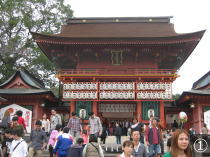
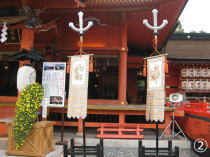
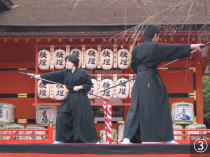
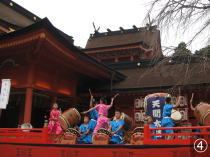
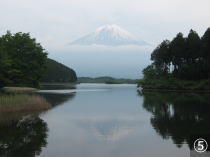

Photo 1, 2, 3 and 4:
Taken at Fujijisan Hongu Sengen Taisha during the Taisai Festival in November.
Photo 5: Lake Tanuki and Mt. Fuji
(All photographs by Prudence)
